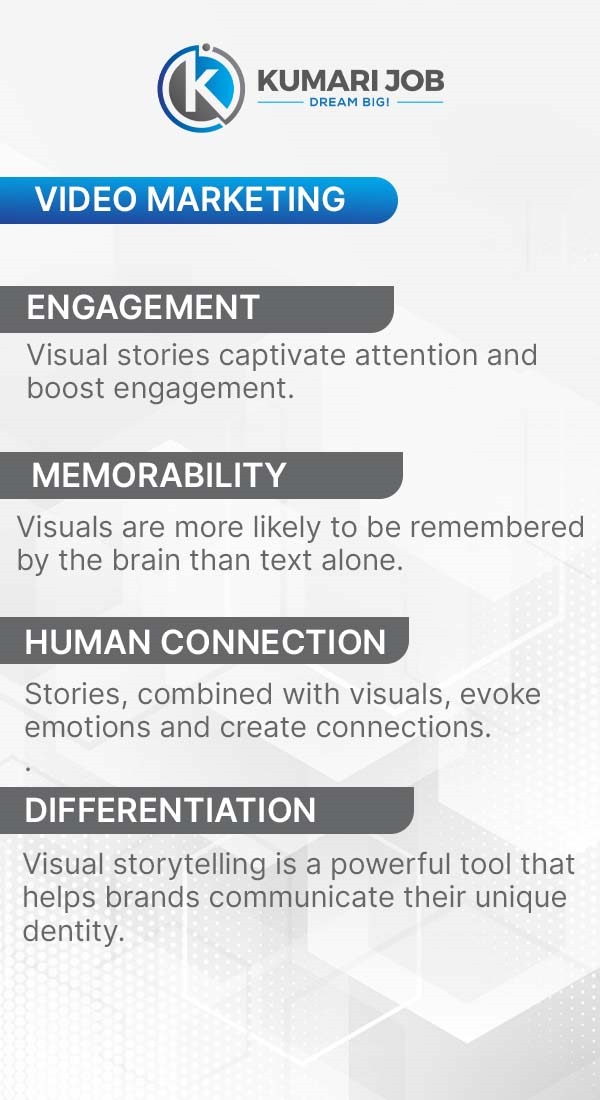What is video marketing?
Video marketing is a powerful digital marketing strategy that businesses use to promote their products or services through engaging video content. This form of marketing leverages the visual medium to convey messages, tell stories, and connect with audiences on a deeper level. From promotional videos and product demonstrations to customer testimonials and educational content, video marketing offers a versatile platform to showcase offerings and build brand awareness.
Video marketing allows businesses to convey complex ideas in a digestible format, making it easier for viewers to understand and retain information. Whether it's showcasing the features of a new product, sharing behind-the-scenes glimpses of company culture, or providing valuable insights into industry trends, videos can effectively communicate messages while entertaining and educating viewers.
In the digital age, businesses must constantly innovate their marketing strategies to stand out in the competition. Video marketing has become a prominent strategy, as it has transformed the way businesses connect with their target audience, offering a unique and engaging experience.
In this blog
The Impact of Video Marketing
Video marketing is one of the tactics that has had the biggest impact in the field of digital marketing. This dynamic and captivating content type has completely transformed how businesses interact with their audience by raising brand visibility, engagement, and conversion rates to unprecedented levels. Let us explore the noteworthy influence that video marketing has exerted on consumers and businesses:
1. Enhanced Engagement: Videos enhance engagement by capturing attention through high-quality visuals, sound, and storytelling, creating immersive experiences, and encouraging active participation and longer viewing times.
2. Increased Brand Awareness: Memorable videos leave lasting impressions, increase social media exposure, and reinforce brand identity and recognition through consistent content.
3. Improved Conversion Rates: Videos effectively communicate product features, benefits, and value propositions, alleviate consumer concerns, drive purchase decisions, and use call-to-action prompts to prompt desired actions.
4. Boosted SEO Performance: Video content improves website engagement metrics, improves search engine visibility, and attracts more clicks and traffic to websites through optimized video metadata.
5. Enhanced Audience Understanding: Video analytics offer insights into viewer behavior, enabling targeted content creation and personalized messaging, while feedback and comments on videos provide direct consumer sentiment and interests.
6. Competitive Advantage: Video marketing helps businesses stand out in saturated markets, differentiates brands from competitors, and establishes industry leadership by early adopting emerging trends.
7. Cross-Platform Versatility: Video content is versatile, adaptable to various platforms, and can be shared, and repurposed across marketing channels for maximum impact and efficiency.
8. Emotional Connection: Visual storytelling effectively connects audiences, builds trust, and evokes emotions, ultimately leading to increased brand loyalty and advocacy.
9. Measurable Results: Advanced analytics tools monitor real-time video performance metrics, quantifying the impact of video marketing efforts through KPIs like views, engagement, and conversions, providing data-driven insights for optimization strategies.
10. Global Reach: Video content, including subtitles, captions, and translations, is accessible to diverse audiences worldwide, while localization efforts drive global expansion and growth.
In conclusion, video marketing significantly enhances engagement, brand awareness, conversion rates, and emotional connections, providing businesses with a competitive edge in the digital landscape.
Know about digital marketing: https://www.kumarijob.com/blog/career-tips/digital-marketing
Tips for Engaging Video Marketing
To maximize the impact of your video marketing efforts, consider the following strategies:
- Know Your Audience: Understanding your target audience's preferences, needs, and pain points is essential for creating content that resonates with them. Conduct market research, gather demographic data, and engage with your audience to gain insights into their interests and challenges.
- Create High-Quality Content: Invest in good equipment, professional editing, and well-scripted content to ensure your videos are of high quality. High-quality videos not only reflect positively on your brand but also captivate and retain viewers' attention.
- Optimize for Mobile: With the increasing use of mobile devices, it's crucial to ensure your videos are mobile-friendly and load quickly on various devices. Optimize video resolution, aspect ratio, and file size for seamless playback on smartphones and tablets.
- Hook Viewers Early: The first few seconds of your video are critical for capturing viewers' attention. Use compelling visuals, intriguing questions, or surprising statements to hook viewers from the start and encourage them to keep watching.
- Tell a Compelling Story: Craft a narrative that evokes emotion and connects with your viewers personally. Whether sharing customer success stories, highlighting your brand's journey, or addressing common challenges, storytelling adds depth and resonance to your videos.
- Use Calls to Action (CTAs): Encourage your audience to take specific actions after watching your videos, such as visiting your website, subscribing to your channel, or purchasing. Clear and compelling CTAs guide viewers toward the next step in their customer journey.
- Utilize social media: Share your videos on social platforms where your audience is most active. Tailor your content to fit each platform's unique format and audience preferences. Engage with your audience, respond to comments, and encourage sharing to maximize reach and engagement.
- Measure and Optimize: Analyze video performance metrics such as view count, watch time, and engagement to understand how your content resonates with your audience. Use these insights to refine your future video content, optimize distribution strategies, and maximize ROI. Regularly monitor performance trends and adapt your approach accordingly to achieve continuous improvement.
Types of Video Marketing Strategies
Let’s explore various engaging video content that can elevate your brand promotion efforts.
- Explainer Videos: Explainer videos are concise, informative videos that clarify complex concepts, products, or services. They often use animation, motion graphics, or live-action to simplify intricate ideas and engage viewers. These videos are invaluable for introducing new products, showcasing features, and addressing FAQs.
- Product Demos: Product demonstration videos provide an in-depth look at how a product works or how it can benefit the consumer. These videos showcase the product’s features, functionality, and usability, helping potential customers make informed purchase decisions.
- Customer Testimonials: Customer testimonial videos feature satisfied customers sharing their experiences with your product or service. Authentic and relatable, these videos build trust and credibility, making them a potent tool for brand promotion.
- Brand Stories: Brand storytelling videos delve into the history, mission, and values of your company. They create an emotional connection with viewers by humanizing your brand and conveying its purpose and vision.
- How-To Tutorials: How-to videos offer step-by-step instructions on various topics, from DIY projects to using your product effectively. These videos position your brand as an expert in your industry and provide value to your audience.
- Behind-the-Scenes Footage: Behind-the-scenes videos provide a glimpse into your company’s inner workings, showcasing the people, processes, and culture behind your brand. They foster transparency and authenticity, strengthening the connection with your audience.
- Animated Videos: Animated videos use animation or motion graphics to convey information in a visually engaging and entertaining manner. They are versatile and can be used for various purposes, from explaining complex concepts to telling stories.
- Webinars and Educational Content: Webinars and educational videos offer in-depth knowledge on specific topics or industries. They position your brand as an authority in your niche and help you connect with a knowledgeable audience.
- User-Generated Content: User-generated content (UGC) involves sharing videos created by your customers or fans. It showcases real people enjoying your products or services, fostering authenticity and trust.
- Event Coverage: Covering industry events, conferences, or even your brand’s events through video helps extend your reach to a broader audience and provides insights into your industry involvement.
Why does visual storytelling matter?
Visual storytelling is the art of conveying a narrative through compelling and evocative visuals. It matters immensely in the world of brand promotion for several compelling reasons:
1. Human Connection: Stories have an innate ability to evoke emotions and create connections. When combined with visuals, they become even more potent, resonating deeply with audiences and leaving a lasting impression.
2. Memorability: Visuals are processed by the brain faster and are more likely to be remembered than text alone. Well-crafted visual stories make brands more memorable in consumers' minds.
3. Differentiation: In a crowded marketplace, visual storytelling sets brands apart. It helps communicate a brand’s unique identity, values, and mission, allowing it to stand out in consumers' minds.
4. Engagement: Visual stories capture and maintain attention better than other forms of content. They encourage viewers to stay engaged longer, increasing the chances of effectively conveying the brand’s message.
How does video enhance storytelling?
Video, in particular, is a dynamic medium that enhances the art of storytelling in unique ways:
- Emotional Depth: Video combines visuals, audio, and sometimes music to create a rich sensory experience. This allows brands to evoke various emotions and convey their narratives with depth and nuance.
- Narrative Flow: Video’s sequential nature makes it an ideal medium for conveying complex narratives. It allows brands to guide viewers through a story, delivering key messages at precisely the right moments.
- Character Development: Video enables brands to introduce and develop characters, whether brand ambassadors, employees, or customers. These characters can become relatable figures, further enhancing the storytelling experience.
- Realism and Authenticity: Live-action videos, testimonials, and behind-the-scenes footage can provide a sense of realism and authenticity that resonates with viewers. Authenticity is a vital aspect of effective storytelling.
- Visual Metaphors: Visual metaphors, symbolism, and imagery can powerfully convey complex ideas or emotions in video storytelling and leave a lasting impact on viewers.
Know about Content Marketing: https://www.kumarijob.com/blog/career-tips/content-marketing
Frequently Asked Questions
- Create a posting schedule
- Include tutorials and demos
- Tell stories
- Show your personality
- Incorporate customer-generated content
- Don't forget calls to action
In simple words, video content strategy is the pooling of knowledge, goals, ideas, and resources in one place. It also involves the planning, creation, distribution, and monitoring of video content. The strategy also includes the colors, tone, branding elements, and ways to improve the viewer experience.
Videos are a Great Way to Explain Your Product
Video content is a useful tool when it comes to helping potential buyers learn about a product. In fact, according to WYZOwl, 94 percent of marketers say using video content has helped increase user understanding of a product or service.
Video marketing makes use of video material to promote goods, give relevant information, and increase sales. Videos are popular because they are educational, entertaining, and emotionally engaging.
Conclusion
Video marketing is a key component of modern digital marketing strategies, enhancing brand awareness, driving conversions, and fostering emotional connections through visually engaging content. Video storytelling allows businesses to create immersive experiences, fostering brand loyalty and advocacy through explainer videos, customer testimonials, and behind-the-scenes footage. Video marketing remains a crucial tool for businesses to connect with their audience in the evolving digital landscape. By utilizing creativity, authenticity, and strategic storytelling, businesses can achieve their marketing objectives and drive long-term success.




